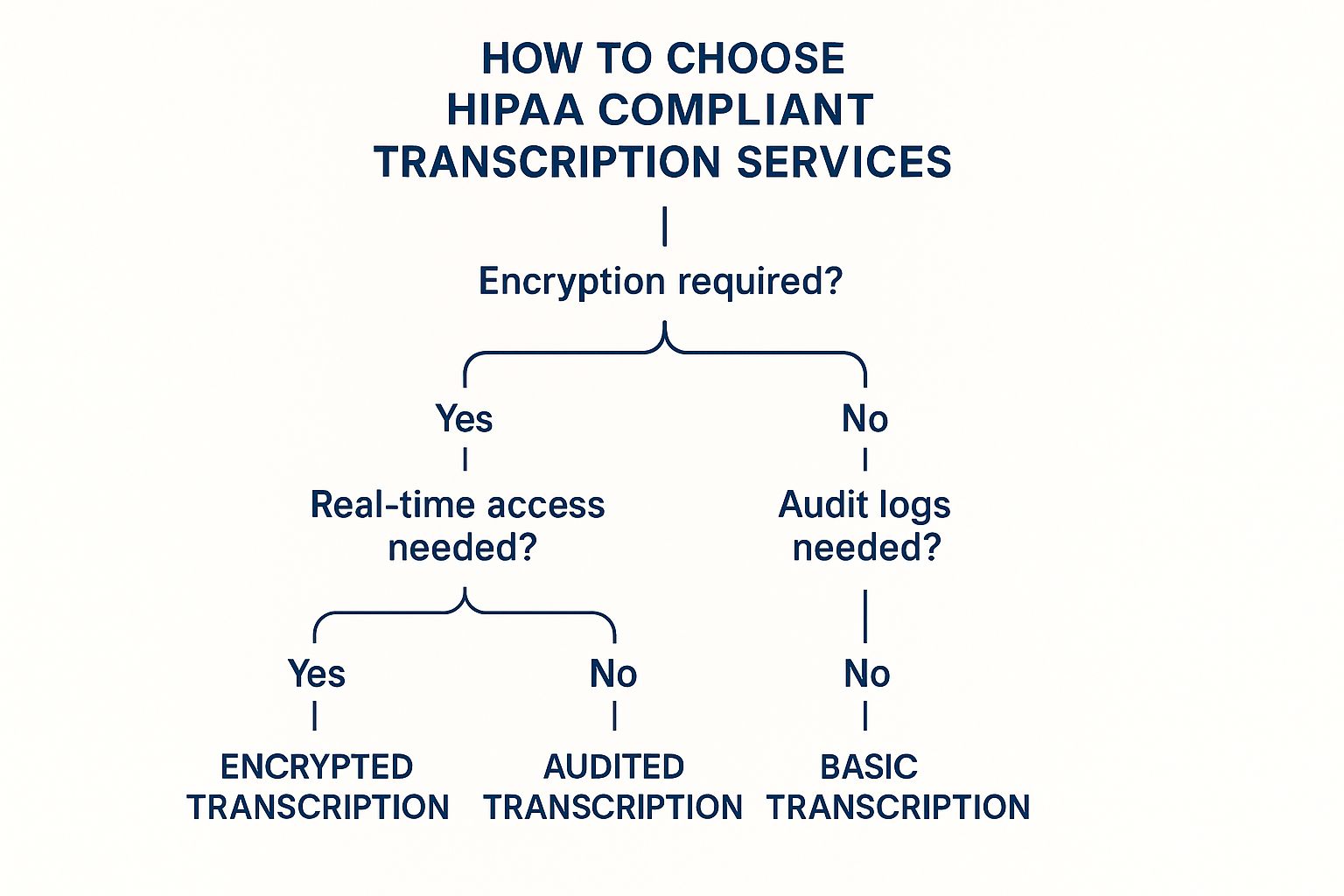Find Trusted HIPAA Compliant Transcription Services Today
When it comes to medical transcription, not all services are built the same. Far from it. Using a standard transcription service for healthcare is a bit like sending sensitive patient files through the mail on a postcard. Anyone can see it. HIPAA compliant transcription services, on the other hand, are the armored truck—a complete system built from the ground up to protect patient information from the moment it's dictated to the final document. For any healthcare provider, they aren't just a good idea; they're a legal and ethical necessity.
Why Standard Transcription Just Won't Cut It in Healthcare

The U.S. transcription market is huge, valued at around $30.42 billion in 2024 and still climbing. This growth comes from all sorts of industries, but healthcare’s needs are in a league of their own, all thanks to the Health Insurance Portability and Accountability Act (HIPAA). If you're interested in the market's growth, you can dig deeper into the data on Grand View Research.
For anyone in a clinical role, understanding the difference between a general transcription service and one that's HIPAA compliant is absolutely vital. A general service might give you an accurate transcript, sure, but it provides zero guarantees about how your data is handled, stored, or sent. It simply doesn't have the necessary safeguards for Protected Health Information (PHI), which leaves your practice wide open to massive risks.
The Problem with Protected Health Information
PHI is any piece of information that can identify a patient—their name, medical record number, address, even the dates they received treatment. Standard transcription platforms aren't designed for this kind of sensitive data. They're typically missing the security protocols that HIPAA demands, things like:
- End-to-end encryption for both audio files and the finished documents.
- Secure access controls to make sure only authorized people can see the information.
- A legally binding Business Associate Agreement (BAA) that makes the vendor accountable for protecting PHI.
Without these in place, using a standard service for medical dictation is a clear HIPAA violation. That can lead to crippling fines, civil lawsuits, and even criminal charges.
Think of it this way: HIPAA compliant transcription isn't just a "nice-to-have" feature. It's the foundation of secure medical documentation. It builds a digital fortress around patient data, guaranteeing confidentiality at every single step.
To truly grasp the gap between these two service types, it helps to see a direct comparison.
Key Differences: Standard vs. HIPAA Compliant Transcription
The table below breaks down the crucial distinctions between a standard transcription service and one that is fully equipped to handle the demands of healthcare.
| Feature | Standard Transcription | HIPAA Compliant Transcription |
|---|---|---|
| Data Security | Basic or no encryption. Data may be stored on unsecured servers. | End-to-end 256-bit AES encryption for all data, in transit and at rest. |
| Access Control | Often uses simple username/password logins. No detailed audit trails. | Multi-factor authentication, role-based access, and detailed audit logs. |
| Legal Agreements | No Business Associate Agreement (BAA). No legal accountability for PHI. | A mandatory, legally binding Business Associate Agreement (BAA) is signed. |
| Personnel | Transcriptionists are not vetted or trained in HIPAA protocols. | All staff undergo background checks and receive ongoing HIPAA training. |
| Data Handling | Files may be sent via unsecured email or FTP, and stored indefinitely. | Secure, dedicated platforms for file upload/download. Strict data retention policies. |
| Compliance | Non-compliant with healthcare regulations. Poses a significant legal risk. | Fully compliant with all HIPAA Security and Privacy Rule requirements. |
As you can see, the differences aren't minor—they represent a fundamental divide in security, accountability, and professional responsibility.
More Than a Law: It's About Trust
This isn't just about checking a legal box. It's an ethical duty. Patients trust you with their most private information, and they expect it to be handled with absolute care. A data breach from an insecure transcription process can shatter that trust in an instant and do lasting damage to your practice's reputation.
When you partner with a provider of HIPAA compliant transcription services, you're sending a clear message to your patients: their privacy matters. You show them you value their security just as much as their health. This specialized approach is the only way to transform spoken words into medical records that are secure, reliable, and legally sound.
The Core Safeguards of Compliant Transcription

When you're looking for a HIPAA-compliant transcription service, you have to look past the shiny marketing claims and dig into the actual security framework. Real compliance isn't just a badge they slap on their website; it's a deep-seated commitment to protecting Protected Health Information (PHI) at every single step. These protections are actually mandated by the HIPAA Security Rule and are broken down into three main categories.
Think of it like securing a fortress. A tall stone wall is a great start, but it's not much good without guards patrolling the perimeter, a logbook of everyone who comes and goes, and a clear set of rules for who can access the royal treasury. A truly secure HIPAA compliant transcription service needs all these layers working together.
Let’s pull back the curtain and see what these safeguards really look like.
Technical Safeguards: The Digital Locks and Keys
First up are the technical safeguards. These are the nuts-and-bolts technology measures a service uses to protect electronic PHI (ePHI). This is your first line of defense against a data breach or someone snooping where they shouldn't be. For any vendor handling sensitive health data, these are absolutely non-negotiable.
Here’s what to look for:
- End-to-End Encryption: This is the big one. It means all data—your audio files, the resulting transcripts—must be scrambled and unreadable both "in transit" (as it travels over the internet) and "at rest" (while it's sitting on a server). Without the right decryption key, an intercepted file is just gibberish.
- Access Control: Not everyone on the team needs access to every patient file. Strong access controls ensure that only authorized people can see or touch PHI, usually based on their specific role. This is the principle of "least privilege"—you only get the keys you absolutely need to do your job.
- Audit Trails: A compliant service must keep a meticulous record of all activity. These audit logs show who accessed PHI, when they did it, and exactly what they did. This digital paper trail is crucial for tracking down the source of any security incident.
A critical part of this is having well-defined rules, and using things like access control policy templates can be a huge help in establishing and documenting these controls.
Administrative Safeguards: The Human Side of Security
Technology is essential, but at the end of the day, security is managed by people. This is where administrative safeguards come in. These are the policies, procedures, and training protocols that govern how the humans in the organization handle PHI. They’re designed to make sure the human element of your security chain is just as strong as the technical one.
The most robust encryption in the world can be undermined by a single untrained employee. That's why administrative safeguards are the backbone of a compliant security program, addressing the human risks that technology alone cannot solve.
A vendor's dedication to these safeguards tells you a lot about how seriously they take their responsibilities. Here are the most important ones:
- The Business Associate Agreement (BAA): This is a legal contract between a healthcare provider and the transcription service (the "Business Associate"). It legally binds the vendor to protect your PHI and makes them directly liable for any breaches they cause. If a vendor won't sign a BAA, walk away. Period.
- Security Personnel and Training: A compliant company will have a designated security officer in charge of developing and enforcing HIPAA policies. More importantly, every single employee who might come into contact with PHI must receive regular, documented training on security rules and their responsibilities.
- Risk Analysis and Management: This isn't a one-and-done checkbox. The service must be constantly performing risk assessments to find potential weak spots in their security and actively working to fix them. It's a proactive, ongoing process.
By understanding these core safeguards, you're in a much better position to vet potential transcription partners and separate the truly compliant from those who just talk a good game. When you combine strong technical defenses with smart administrative policies, you create the layered security needed to truly protect patient data.
How to Evaluate and Select the Right Service
Choosing the right partner for HIPAA compliant transcription services is about more than just checking boxes on a feature list. You’re not just buying a service; you're entrusting a vendor with some of the most sensitive data imaginable: Protected Health Information (PHI). Your evaluation process needs to reflect the seriousness of that responsibility.
It's easy to get swayed by marketing claims, but that's a risky path. A better approach is to have a structured framework to verify their security promises and make sure they can prove it. Asking the right questions shifts the conversation from a sales pitch to a serious discussion about compliance and data protection. Think of it as your first line of defense against a potential data breach.
The Non-Negotiable Starting Point: The BAA
Before you get into the weeds of turnaround times or pricing, there's one simple, direct question to ask: "Will you sign a Business Associate Agreement (BAA)?" This is a pass/fail test, plain and simple. The BAA is a legal contract that makes the transcription service accountable for protecting PHI and directly liable for any breaches that happen on their end.
If a potential vendor hesitates, resists, or flat-out refuses to sign a BAA, walk away. It's the single biggest red flag you can encounter and a clear sign they aren’t a serious or compliant partner.
There are absolutely no exceptions here. Any legitimate provider of HIPAA compliant transcription services will have a BAA ready to go and will expect you to ask for it.
Digging Deeper into Security Protocols
With a BAA on the table, it's time to get specific about their security measures. Don't settle for vague assurances like "we use bank-level security." That doesn't mean anything without details. You need concrete answers that show they truly understand HIPAA's technical side.
Here are the critical security questions you need to ask:
- Encryption Standards: "What kind of encryption do you use for data both in transit and at rest?" Look for a specific answer, like AES-256 bit encryption, which is the gold standard for securing data.
- Data Handling Procedures: "Can you walk me through your data lifecycle? How are files uploaded securely, where are they stored, and what's your policy for permanently deleting data after transcription?" A compliant provider will have clear, documented procedures for every step.
- Access Controls: "How do you control and monitor who can access our data?" The right answer involves things like multi-factor authentication, role-based access controls, and detailed audit trails that log every single interaction with PHI.
This line of questioning helps you separate the services that just talk about compliance from those that have built their operations around it. With the growing need for outsourced services to bolster clinical documentation improvement, this level of scrutiny is more important than ever.
The decision tree below can help you visualize how your specific needs might guide you toward certain service features.

As the graphic shows, foundational security like encryption and audit logs are non-negotiable for any compliant service. More advanced features, like real-time access, cater to specific operational workflows. This really drives home the importance of matching a vendor's capabilities to what your practice actually needs day-to-day.
Vendor Evaluation Checklist
To help you stay organized and compare providers systematically, we've put together this checklist. Use it to guide your conversations and ensure you cover all the critical bases before making a decision.
| Evaluation Criteria | Questions to Ask | Ideal Response / Red Flags |
|---|---|---|
| Business Associate Agreement (BAA) | Will you sign our BAA, or do you have a standard one we can review? | Ideal: Yes, absolutely. We have a standard BAA ready. Red Flag: Hesitation, refusal, or attempts to avoid signing. |
| Data Encryption | What encryption standards do you use for data in transit and at rest? | Ideal: We use AES-256 bit encryption for both. Red Flag: Vague answers like "it's secure" or mentioning outdated standards. |
| Access Controls | How do you limit and track access to our data? | Ideal: We use role-based access, multi-factor authentication, and maintain detailed audit logs of all activity. Red Flag: No clear system for limiting access or monitoring user actions. |
| Data Storage and Deletion | Where is our data stored? What is your data retention and deletion policy? | Ideal: Data is stored in HIPAA-compliant data centers. We have a clear policy for permanent deletion after a set period. Red Flag: Unclear storage locations or no defined policy for data destruction. |
| Accuracy and Quality Assurance | What is your process for ensuring transcription accuracy? | Ideal: A multi-step review process involving human editors and quality checks. Red Flag: Relying solely on automated transcription with no human oversight. |
| Support and Reliability | What are your support hours and typical response times? | Ideal: Clearly defined support channels (phone, email) with stated response times. Red Flag: No dedicated support or unclear service level agreements (SLAs). |
Using a structured checklist like this ensures you conduct a thorough, consistent evaluation for every vendor, making your final decision much clearer and more defensible.
Benefits Beyond Basic Compliance

When you partner with a provider for HIPAA compliant transcription services, you’re doing more than just checking a box to avoid fines. Of course, steering clear of penalties is a huge plus, but the real value lies in how it strengthens your practice from the inside out. It's about turning a compliance requirement into a powerful tool that boosts your operations, lowers your risk, and ultimately improves patient care.
The most obvious win is risk management. A data breach can be catastrophic, not just financially, but to the trust you've built with your patients. A compliant transcription partner is like adding another layer of armor, protecting your practice from the fallout of a security breach tied to your documentation process.
This forward-thinking approach to security is a cornerstone of any modern healthcare practice. As we explore in our guide on data security in healthcare, building these strong defensive walls is what creates a truly resilient organization.
Unlocking Operational Efficiency and Reducing Burnout
One of the biggest practical benefits is getting tedious administrative tasks off your clinical staff's plate. Every minute a doctor, nurse, or medical assistant spends typing up notes or wrestling with a flawed automated draft is a minute they aren't spending with a patient. It's a waste of their expertise.
Outsourcing documentation directly tackles this administrative drain. This single change can dramatically improve team morale and help combat the all-too-common problem of clinician burnout. By letting experts handle the transcription, you free up your team to focus on their most important work.
This boost in efficiency creates a positive ripple effect across your entire practice:
- Faster Chart Completion: Clinicians can quickly dictate their notes between appointments and get back to their day, confident that an accurate transcript will be waiting for them.
- Reduced Administrative Overhead: You'll see a real drop in the hours your team spends typing, formatting, and proofreading, which translates directly into cost savings.
- Improved Focus: Your medical professionals can dedicate their full attention to diagnosing and treating patients instead of being distracted by paperwork.
Strengthening Your Legal and Financial Position
Clean, accurate, and securely handled documentation is your best friend in any legal or financial review. Should you face an insurance audit, a billing dispute, or a malpractice claim, having a precise, timestamped transcript is powerful proof of the care provided. It creates an unimpeachable audit trail that can be a lifesaver.
Think of a secure transcript as more than just a medical note—it’s a legal document. During an audit, it offers undeniable proof of services rendered, strengthening your billing claims and shielding you from clawbacks.
The growing demand for this level of precision is clear. The U.S. general transcription market, which includes the medical field, is expected to top $32 billion by 2025. A huge part of that growth comes from the non-negotiable need for accurate, compliant documentation.
Better transcripts also mean cleaner, faster billing. When your documentation perfectly reflects the services you provided, insurance claims sail through the approval process. This means fewer denials and quicker reimbursements. The best HIPAA compliant transcription services can even help you master EMR system integration, pushing that accurate data directly into patient records and billing software. That connection between transcription and your EMR is where you'll find the biggest gains, improving the financial health of your entire practice.
The Human Touch in an AI-Powered World
In modern transcription, it often feels like a showdown between AI systems and skilled human professionals. But when it comes to healthcare, this isn't an either/or debate. The most reliable HIPAA compliant transcription services have figured out that the real power lies in blending the two into a smart, hybrid model.
Artificial intelligence definitely brings some serious muscle to the process, especially when it comes to speed and cost. An AI can churn out a rough draft of an hour-long recording in minutes—a job that would take a human transcriptionist much, much longer. This raw speed provides an incredible head start.
But that’s where the easy part ends. AI’s weaknesses quickly surface when it bumps up against the messy reality of medical conversations.
Where AI Needs a Helping Hand
For all their power, AI systems often stumble over the very details that are most critical in a medical setting. They can get tripped up by thick accents, struggle to follow a fast-paced conversation with overlapping speakers, or completely miss the context behind a doctor’s casual remark. A machine might not know the difference between "a history of falls" and "a history of Falls disease," a small distinction with massive implications.
On top of that, complex medical jargon, similar-sounding drug names, and common homophones can easily confuse an algorithm. An AI might deliver a transcript that’s 90% accurate, but that last 10% could hide a critical error affecting a diagnosis, treatment plan, or billing code.
A transcript that is "mostly accurate" simply isn't good enough in healthcare. The final document must be flawless. Even a tiny mistake in a diagnosis, medication, or patient instruction can lead to serious consequences, which is why human expertise is non-negotiable.
The Irreplaceable Value of Human Review
This is precisely where the human expert steps in. A trained medical transcriptionist does more than just type; they apply critical thinking and deep medical knowledge to make sure every word is perfect. They’re not just transcribing sounds, they’re interpreting meaning.
These professionals are specifically trained to:
- Discern Complex Terminology: They know how to correctly identify and spell complicated medical terms and drug names that an AI would likely garble.
- Interpret Accents and Nuance: The human ear is still unmatched at understanding diverse accents, muffled audio, or the subtle tone changes that communicate intent.
- Ensure Contextual Accuracy: A human reviewer will spot things an AI never could, like a statement that doesn’t make clinical sense or a misplaced "not" that reverses a diagnosis.
The best HIPAA compliant transcription services use this balanced approach. The AI handles the initial heavy lifting, and then a qualified human expert meticulously reviews, edits, and refines the draft. This system gives you the speed of automation with the confidence that only comes from a human final check. You can learn more about what it takes to become this kind of expert in our guide on medical transcription training.
Answering Your Questions About HIPAA Transcription
When you're dealing with patient data, it's natural to have a lot of questions. After all, protecting your patients' privacy and your practice's legal standing is paramount. Let's walk through some of the most common questions and concerns we hear from healthcare professionals about HIPAA compliant transcription services.
"Can't I Just Use a Regular Service and Remove Patient Names?"
This is a common question, and it points to a very dangerous misunderstanding of HIPAA. The short answer is no, absolutely not.
HIPAA identifies 18 specific identifiers that are considered Protected Health Information (PHI). A patient's name is just one of them. Things like medical record numbers, dates of service, or even specific geographic details can all be used to identify an individual. Simply deleting a name doesn't come close to properly de-identifying a record by legal standards. A truly compliant service is built from the ground up to protect all PHI, secured by a formal Business Associate Agreement (BAA).
"Is a Service Compliant Just Because Their Website Says So?"
Not always. A "HIPAA Compliant" badge on a website is just a marketing claim until it's backed up with proof. It's easy to make a claim, but true compliance requires a serious legal and technical commitment.
The single most important piece of proof is the vendor's willingness to sign a Business Associate Agreement (BAA). This is the legally binding contract that holds them accountable for protecting PHI. If a vendor won't sign a BAA, their claims of compliance are meaningless.
Beyond that essential legal document, you need to dig into their security measures. Ask about their encryption methods, who can access the data, and what kind of HIPAA training their team undergoes. Real compliance is demonstrated through actions and agreements, not just words on a homepage. For a deeper dive, you can use our HIPAA compliance requirements checklist.
"What Happens if My Transcription Provider Has a Data Breach?"
If your transcription partner has a data breach, the BAA legally requires them to notify you immediately. The HIPAA Breach Notification Rule makes your vendor directly liable for their own security lapses and the resulting fallout.
However, your practice still shares in the responsibility. You are ultimately the one who must notify affected patients and the Department of Health and Human Services (HHS). This is exactly why it's so critical to choose the right partner from the start. A vendor with strong security and a clear plan for handling incidents is your best defense against risk and, more importantly, helps protect your patients from potential harm.
Ready to stop worrying about compliance and start focusing on your patients? Whisperit provides a secure, accurate, and efficient AI dictation platform built on a foundation of Swiss privacy standards. See how much time you can save by visiting https://whisperit.ai today.